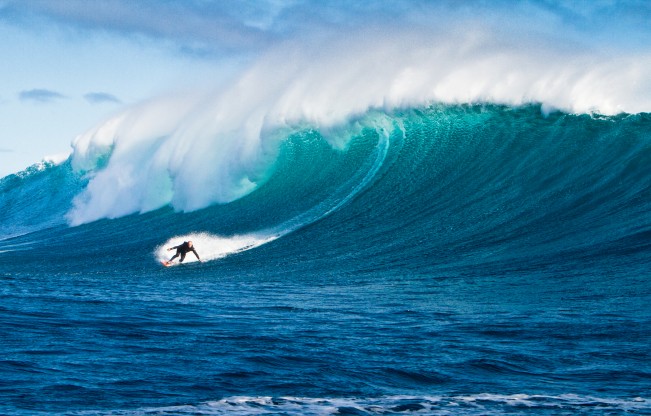By Jake Howell jake.howell@utoronto.ca
The Torontonian Reviews: Storm Surfers 3D
A 3D documentary about riding massive waves, Storm Surfers follows Tom Carroll and Ross Clark-Jones, two world-class boarders who are pushing 50 and enjoying the twilight of their careers. Best friends and professional partners, they’ve moved on from the days of reckless water-chasing and winning competitions, but they’re still superstars in their element.
Because they’re older now, Tom and Ross approach surfing with less abandon and more humility. While they still want to ride the fastest, biggest waves possible, they also want to return home to their wives and kids at the end of the day. That’s why they’ve befriended storm forecaster Ben Matson, a weather whiz who helps the two scout where storm swirls are generating. Matson plots the trajectory and force of these storms, granting the team plenty of time to prepare a mission out from HQ. The goal is to find uncharted, previously unsurfed water, and exploration is the name of the game.
Storm Surfers was shot natively in 3D, and for once a film is better for it. The added dimension instills a greater sense of scale, reminding us of the inherent danger to this thrilling sport. Thankfully, none of this ever feels shoehorned: water froths at the screen like it would while boating; waves in the foreground seem touchable. This isn’t a gimmick, because the filmmakers have used the medium with legitimate intentions.
(Side-note, but the two images also appear to be split further apart than the majority of 3D films, making the “pop” effect of 3D seem deeper in Storm Surfers. The technology accomplishes what Hollywood has failed to replicate much since Avatar: the screen becomes a portal into another world.)
Directors Justin McMillan and Christopher Nelius have secured some breathtaking images here, be it via helicopter or GoPro cameras attached to various seacraft. There are also several shots filmed by the surfers themselves, accomplished by holding a camera out behind them. These handheld shots are the likely most astonishing thing about Storm Surfers, because they present an unprecedented 3D look into what it’s like to ride the “curl”, whether or not the surfers remain standing by the time their ride is over. Cross that off the bucket list, then.
By also documenting the ever-growing modesty of the surfers, the film is elevated from “exciting surfing footage” to an interesting, albeit unusual portrait of the human spirit. These best friends know their limits and don’t pretend to go further than they are capable of, as their families are just as important as wave-chasing. This gives the film some extra buoyancy, as the remainder of the film is cinematic water-riding. For some, this could and will result in some audience wipeouts.
It seems almost criminal to call Storm Surfers repetitive, as it implies a sense of boredom with the natural world. Don’t get me wrong: thirty-foot waves are marvelous to behold, and seeing maniacs surf them is even more so. Unfortunately, as the 50th wave crashes exactly the same way the previous 49 did, the film begins to submerge. Storm Surfers never sinks very far, however, because of some slick editing and top-notch transitions. McMillan and Nelius employ fancy maps and detailed graphs to make basic meteorology look sexy.
As documentaries go, Storm Surfers is a rather ambitious one – these are characters who risk their lives for great footage. They’ve succeeded, which is to our benefit (and theirs too, by the looks of how much fun they have on “set”). The film is ultimately worth it; both for those interested in seeing excellent 3D and viewers looking for a more thoughtful adventure doc.
















